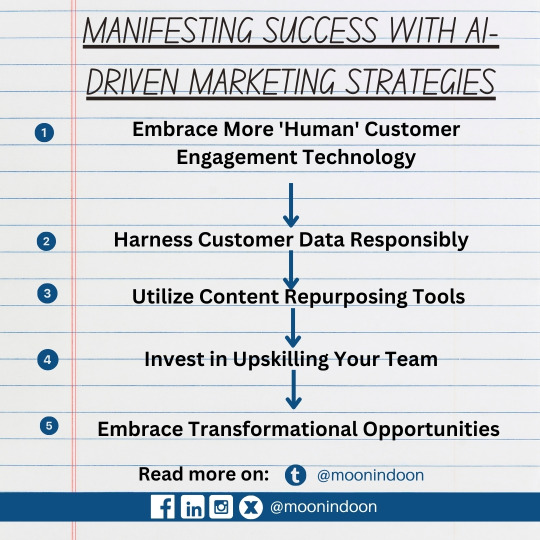#Generative AI Strategies
Explore tagged Tumblr posts
Text
Strategic Approaches to Generative AI Adoption in Enterprises

In the past twelve months, the corporate landscape has been abuzz with the potential of generative AI as a groundbreaking innovation. Despite broad recognition of its transformative power, many firms have adopted a tentative stance, cautiously navigating the implementation of this technology.
Is a cautious approach prudent, or does it inadvertently place companies at risk of lagging in a rapidly evolving technological landscape?
Recent investigations forecast the staggering benefits of generative AI, suggesting potential productivity gains in trillions of dollars per annum by 2030 if harnessed effectively.
The rewards surpass the apprehensions, provided the adoption of this technology is executed with strategic foresight. It's not about restricting generative AI but about sculpting its usage within well-defined parameters to mitigate potential challenges, including uncontrolled expenses, security breaches, compliance issues, and employee engagement.
Below, we outline ten strategic approaches for enterprises to capitalize on generative AI effectively and securely.
Adopt a Streamlined Approach to Business Case Development: Generative AI, an emerging technology, demands a departure from traditional business case development. Enterprises should prioritize rapid experimentation and learning to pinpoint practical technology applications swiftly. Discover and Explore
Action Points:
Accelerate pilot projects and proof-of-concept initiatives to cultivate knowledge and skills.
Discover and Explore and Test on repeat
Avoid:
Postponing initiatives due to the need for more absolute clarity.
Over-reliance on cumbersome business case development processes.
Initiate with Straightforward Applications: Before venturing into more complex applications, begin by unlocking value within existing business processes.
Action Points:
Concentrate on internal applications as foundational steps.
Prioritize data readiness for customized solutions.
Avoid:
Early deployment of customer-facing applications due to higher associated risks.
Use case lock where you’re working to solve a specific problem in one particular way.
Streamline Technology Evaluation: Most generative AI tools offer similar capabilities, rendering extensive evaluation unnecessary.
Action Points:
Collaborate with firms like Karini.ai for initial use cases whose platform provides immediate access to no-code tools for operationalizing Gen AI smartly.
Focus on trust and integration capabilities that open your LLMs, Models, and Data to all available options.
Avoid:
Elaborate and potentially outdated analysis of technology providers.
Vendor lock on a single platform that will cause crippling limitations.
Harness External Expertise: The scarcity of AI expertise necessitates partnerships for successful implementation and integration.
Action Points:
Assess internal expertise gaps, seek external support accordingly, and embrace a low-code/no-code platform, i.e., Karini.ai, which will keep the journey quick and safe.
Facilitate technology assimilation into the enterprise.
Avoid:
Isolated attempts at implementation.
Restrictive partnerships limit future technological choices.
Design a Flexible System Architecture: Architectures must be dynamic to accommodate evolving technologies, use cases, and regulatory landscapes.
Action Points:
Foster innovative and forward-thinking architectural design.
Anticipate and plan for future architectural adjustments.
Avoid:
Rigid architectures based on present-day technology functioning.
Over-reliance on existing processes for future technology support.
Implement Robust Security Protocols: Addressing generative AI's unique security challenges through custom policies and robust partnerships.
Action Points:
Develop tailored policies and procedures.
Partner with platforms that are active protectors of your data security.
Avoid:
Dependence on outdated security frameworks.
Technology adoption paralysis due to fear of risk.
Establish Innovative KPIs: New KPIs should reflect generative AI's unique value and impact on business operations.
Action Points:
Develop KPIs centered around long-term value creation.
Learn from both successes and failures.
Avoid:
Ignoring the learning opportunities presented by unsuccessful initiatives.
Foster Open Communication: Ensure continuous feedback and open communication channels for iterative improvement and employee engagement.
Action Points:
Integrate feedback mechanisms into all AI systems, like Karini uses in our CoPilot. 👍👎💬
Maintain transparent communication about AI's impact on the workforce.
Avoid:
Relying solely on conventional feedback methods.
Promote Comprehensive Learning and Development: Equip employees with the necessary skills and understanding to leverage AI tools effectively.
Action Points:
Provide extensive learning opportunities; Gen AI is empowering.
Align learning initiatives with broader change management strategies.
Avoid:
Limiting learning opportunities to direct users of AI tools AI needs to be democratized.
Embrace Iterative Learning: Cultivate a learning and continuous improvement culture to maximize the value derived from generative AI.
Action Points:
Prioritize learning and skill enhancement.
Engage in iterative development to refine use cases and technology applications.
Avoid:
Pursuing overly ambitious initial use cases.
Disregarding the evolving nature of AI technologies.
As enterprises stand at the cusp of this generative AI revolution, adopting a 'wait-and-see' approach may inadvertently place them at a competitive disadvantage.
The promise of generative AI far overshadows the perceived risks, demanding proactive engagement rather than cautious observation. Now is the opportune moment for enterprises to embrace generative AI, navigating its introduction with calculated measures to offset potential risks.
For further insights, explore our website or engage with our team.
About us:
Fueled by innovation, we're making the dream of robust Generative AI systems a reality. No longer confined to specialists, Karini.ai empowers non-experts to participate actively in building/testing/deploying Generative AI applications. As the world's first GenAIOps platform, we've democratized GenAI, empowering people to bring their ideas to life – all in one evolutionary platform.
Contact us:
Jerome Mendell
(404) 891-0255
#Generative AI Best Practices#Enterprise Gen AI Integration#Karini AI Gen AI Guide#Generative AI Strategies#Mastering Generative AI#artificial intelligence#generative ai#chatgpt#machine learning#karini ai
1 note
·
View note
Text
been playing expedition 33 since its on gamepass, oh my god. hardcore game of the year potential for me. i looooooooove turn based combat and i love real time parry systems so its just the best of all worlds for me. and the art direction is fucking fantastic. ive never cried during the prologue of a game before but the gommage had me in real tears (crying bc of a game is rare in general for me, and usually reserved for the endings of games like red dead 2, bg3, etc.). the combat system is so novel
#im playing on expert difficulty of course.#the only thing is i wish it was more strategy reliant like expert difficult IS hard but it feels like the hardness just comes from#damage scaling and i wish it was more difficult strategy wise#like more complex/intelligent AI for the boss moves#and in general more complex boss moves would be more fun. like more statuses/moves that do more than just damage#maybe that comes later i dunno. im just past the gestral village and the big flying guy !#ramblings#ace plays e33
14 notes
·
View notes
Text

"Alexander Strategizes"
#ai men#ai generated#ai artwork#ai art community#gay ai art#art direction#fashion illustration#alexander the great#abdominals#thinking#strategy#ancient times#gay art#muscular definition#ancient history#homoerotic
22 notes
·
View notes
Text
🚀 Explore how AI can transform your B2B marketing strategy! Discover actionable tactics to enhance buyer engagement and create personalized experiences. Dive into AI-driven buyer-centric strategies today! #B2BMarketing #AI #BuyerEngagement #DigitalMarketing
#account-based marketing#AI#AI-driven marketing#automated nurturing#B2B marketing#brand awareness#buyer enablement#buyer experiences#buyer journeys#buyer-centric strategies#buying groups#campaign effectiveness#content distribution#conversion rate optimization#customer engagement#data analysis#demand intelligence#digital marketing#engagement#lead generation#marketing automation#marketing insights#multi-touch attribution#omnichannel experience#performance insights#personalization#resource optimization
4 notes
·
View notes
Text
SmartBot Strategies: Making Sense of AI Image Generators
SmartBot Strategies: Making Sense of AI Image Generators
The world of AI is evolving fast—and for creators, marketers, and small business owners, one of the most exciting tools right now is the AI image generator. These powerful programs take simple text and turn it into stunning visuals in seconds. But with so many tools out there, finding the right one can feel like guesswork.
That’s where SmartBot Strategies comes in.
Founded in 2024 and backed by over a decade of experience in content and automation, SmartBot Strategies isn’t just another tech blog. It’s a trusted educational resource helping everyday users figure out what is the best AI image generator—without hype, without jargon, and without pushing any specific platform.
Why This Matters
Most websites reviewing AI tools are either sponsored or overloaded with technical talk. SmartBot Strategies is different. It creates detailed, easy-to-read guides that help regular users—designers, bloggers, freelancers, and solopreneurs—understand how to use AI image tools effectively and ethically.
Whether you're curious about DALL·E, Midjourney, Stable Diffusion, or the latest free tools, SmartBot Strategies breaks it all down clearly. The content shows how to generate better results, fine-tune your prompts, and even avoid common mistakes—no coding required.
Practical Help for Real Projects
One of the biggest reasons readers love SmartBot Strategies is how practical the advice is. Their blog explains how to use AI images for:
Social media graphics
Blog post visuals
Marketing campaigns
Personalized gifts and designs
Instead of just saying “this tool is cool,” SmartBot Strategies shows how to use it in real life.
Creators can learn how to streamline their design process. Small business owners can see how AI-generated images can replace time-consuming graphic design work. Even hobbyists can find fun, creative ways to explore their ideas visually—without needing expensive software.
Community-Driven, Not Corporate
Another key difference? SmartBot Strategies is all about education, not promotion. You won’t find pushy affiliate links or one-size-fits-all recommendations. Instead, the site focuses on building a community of curious, capable AI users.
With step-by-step walkthroughs, video tutorials, and tool comparisons, it caters to learners of all backgrounds—especially visual thinkers who want to see how things work. And with growing activity on platforms like YouTube and Medium, it’s quickly becoming one of the most trusted names in AI learning.
Final Thoughts
If you’re looking to understand AI image generators and start using them with confidence, SmartBot Strategies is your go-to source. It’s educational, unbiased, and incredibly user-friendly.
In a world full of AI noise, SmartBot Strategies helps you focus on what matters: results, clarity, and smarter workflows.
🌐 Visit SmartBotStrategies.com 📧 Questions? Reach out at [email protected]
#What is the best AI image generator#What does an AI image generator do?#How do AI image generators work?#Can AI create realistic images from text?#Smartbot strategies explains the best AI image generator
2 notes
·
View notes
Text
How Generative AI Is Revolutionizing SEO Strategy in 2025
In 2025, generative AI is reshaping how marketers approach SEO by prioritizing user intent, conversational content, and contextual relevance. Traditional keyword stuffing is being replaced with smarter AI-driven content strategies that deliver real value. Tools like Google’s SGE and ChatGPT are transforming search results, making it essential for brands to optimize for AI-powered platforms. With generative AI SEO strategies, content must be more human-centric, structured and authoritative. At SeoBix we help businesses stay ahead by crafting SEO strategies that align with AI’s evolving algorithms. This new era of SEO demands innovation and generative AI is leading the charge.
For More Information Visit Our Website - www.seobix.com
2 notes
·
View notes
Text
ETHICS EXAM DONE

#MY HAND IS CRAMPING SO BAD#hey guys don’t hand write two essays in an hour and a half ok it’s bad for you#(it’s bc my prof hates ai and this is the most foolproof strategy so I don’t mind)#it went pretty well tho!!!#ethics and philosophy is my best subject and just a general passion of mine outside of school#so I don’t mind + my worry was kinda for naught bc I forget how good I am lmao#but it was not worth waking up at 5 am and arriving at the school at 6:30 for. what the hell.#anyway I just feel like yapping today😁#LC screams
5 notes
·
View notes
Text
Ultimate Guide to DeepSeek AI for Business Growth
Table of Contents of DeepSeek AI for Business Growth1. Introduction: Why AI is Essential for Modern Business Growth2. What Is DeepSeek AI?3. Top 5 DeepSeek AI Tools for Scaling Businesses3.1 Demand Forecasting Engine3.2 Customer Lifetime Value (CLV) Predictor3.3 Automated Supply Chain Optimizer3.4 Dynamic Pricing Module3.5 Sentiment Analysis Hub4. How DeepSeek AI Reduces Costs and Boosts…
#AI automation 2024#AI budgeting#AI business growth#AI for non-tech teams#AI for startups#AI implementation guide#AI in retail#AI supply chain#Business Intelligence#cost reduction strategies#data-driven decisions#DeepSeek AI#enterprise AI adoption#fintech AI solutions#generative AI for business#Predictive Analytics#ROI optimization#scaling with AI#SME AI tools#startup scaling
2 notes
·
View notes
Text
Cybersecurity vs. SaaS Marketing: Why Selling Security Is a Whole Different Game
Selling cybersecurity isn't the same as selling SaaS. This post explores the unique challenges and strategies involved in marketing security solutions. Learn why trust, risk aversion, and compliance play a crucial role in cybersecurity sales, and how to tailor your approach for success.

In the world of B2B tech, marketing cybersecurity solutions is like playing chess while everyone else is playing checkers. It's more complex, higher stakes, and requires a completely different strategy. This article dives into why marketing cybersecurity products is so different from selling your average SaaS solution, and why it matters for your business.
Think about it: When you're marketing a typical SaaS product, you're selling efficiency, productivity, or cost savings. But with cybersecurity? You're selling peace of mind in a digital world full of threats. It's not just about making life easier—it's about keeping businesses safe from invisible dangers.
Here's what we'll uncover:
Why cybersecurity products are trickier to explain (and sell)
How building trust is your secret weapon in security marketing
The constant race against new threats (and how it affects your marketing)
Why your customers might not know they need you (until it's too late)
Navigating the maze of regulations and compliance
Whether you're a marketer looking to level up your skills, a business owner trying to protect your digital assets, or just curious about how the world of cybersecurity ticks, this article will shed light on why marketing in this field is a unique challenge—and an exciting opportunity.
The Need for Specialized Marketing Skills in Cybersecurity
Before we dive into the specific differences, it's crucial to understand why cybersecurity marketing requires a specialized skill set:
Technical Proficiency: Cybersecurity marketers need a deep understanding of complex technical concepts to effectively communicate product value.
Risk Communication: Balancing the need to convey urgency without resorting to fear-mongering requires a nuanced approach.
Regulatory Knowledge: Familiarity with various compliance standards and regulations is essential for credible marketing in this space.
Rapid Adaptation: The ever-evolving threat landscape demands marketers who can quickly pivot strategies and messaging.
Trust Building: In a field where skepticism is high, marketers must excel at building and maintaining trust through every interaction.
Now, let's explore the five critical areas that make cybersecurity marketing a different beast from its SaaS counterparts, and learn how savvy marketers are rising to meet these challenges head-on.
1. Complexity of the Product
Cybersecurity Marketing
Cybersecurity solutions often involve intricate technologies and specialized knowledge. The products are designed to protect against sophisticated threats and vulnerabilities, which can be difficult for non-experts to fully grasp. As a result, cybersecurity marketers face the challenge of:
Simplifying complex concepts without losing their technical essence
Educating potential customers on the importance and functionality of various security measures
Balancing technical accuracy with accessibility to appeal to both IT professionals and business decision-makers
Specialized Skill: The ability to translate highly technical concepts into clear, compelling narratives that resonate with both technical and non-technical audiences.
Traditional SaaS Marketing
While SaaS products can also be complex, they often focus on solving more straightforward business problems. Marketers of traditional SaaS products typically:
Highlight user-friendly interfaces and intuitive functionality
Focus on immediate business benefits and ROI
Use less technical jargon in their marketing materials
2. Emphasis on Trust and Credibility
Cybersecurity Marketing
Trust is paramount in cybersecurity. Organizations are essentially entrusting their digital assets and sensitive information to the cybersecurity solution provider. To build this trust, cybersecurity marketers must:
Demonstrate deep expertise in the field
Showcase a proven track record of protecting against threats
Utilize case studies and customer testimonials extensively
Produce thought leadership content to establish authority
Highlight certifications, compliance, and industry recognition
Specialized Skill: The ability to build and maintain trust through every marketing touchpoint, from content creation to customer interactions.
Traditional SaaS Marketing
While trust is important for all SaaS products, the stakes are generally lower. Traditional SaaS marketers focus on:
User reviews and ratings
Ease of use and customer support
Integration capabilities with other tools
Cost-effectiveness and scalability
3. Rapidly Evolving Threat Landscape
Cybersecurity Marketing
The cybersecurity field is in a constant state of flux, with new threats emerging regularly. This dynamic environment requires cybersecurity marketers to:
Stay informed about the latest threats and trends
Quickly adapt marketing messages to address emerging challenges
Demonstrate how their solutions evolve to counter new risks
Educate the market about new types of threats and vulnerabilities
Position their products as forward-thinking and proactive
Specialized Skill: The ability to rapidly assimilate new information about emerging threats and translate it into compelling marketing messages and strategies.
Traditional SaaS Marketing
While innovation is important in SaaS, the pace of change is typically slower. SaaS marketers often focus on:
Long-term value proposition and stability
Gradual feature improvements and updates
Industry trends rather than immediate threats
4. Target Audience's Risk Awareness
Cybersecurity Marketing
Many organizations take a reactive approach to cybersecurity, only prioritizing it after experiencing a threat. This creates unique challenges and opportunities for marketers:
Educating potential clients about the importance of proactive measures
Using fear-based marketing carefully to highlight risks without being alarmist
Demonstrating the cost of inaction through real-world examples
Targeting both technical (CISOs, IT managers) and non-technical (CEOs, CFOs) decision-makers
Specialized Skill: The ability to effectively communicate risk and urgency without resorting to fear-mongering, while also tailoring messages to different stakeholders within an organization.
SaaS Marketing
Traditional SaaS products often address known pain points or inefficiencies. Marketers typically focus on:
Highlighting productivity gains and cost savings
Showcasing how the product solves existing problems
Appealing to a more defined set of decision-makers within an organization
5. Regulatory and Compliance Considerations
Cybersecurity Marketing
Cybersecurity solutions must often adhere to specific regulatory standards, adding another layer of complexity to marketing efforts:
Communicating compliance capabilities effectively
Addressing concerns related to data protection laws (e.g., GDPR, CCPA)
Highlighting adherence to industry-specific regulations (e.g., HIPAA for healthcare)
Demonstrating how the solution helps clients meet their own compliance requirements
Specialized Skill: A deep understanding of various regulatory frameworks and the ability to articulate how cybersecurity solutions address compliance requirements.
General SaaS Marketing
While some SaaS products may need to address compliance, it's typically not as central to the marketing message:
Focus on general data security and privacy features
Highlight any relevant certifications (e.g., SOC 2)
Address compliance as a feature rather than a core selling point
The Learning Curve for B2B SaaS Marketers
For B2B SaaS marketers transitioning into cybersecurity, the learning curve can be steep and time-consuming. Here's why:
Technical Knowledge Acquisition: Understanding the intricacies of cybersecurity technology, threat landscapes, and defense mechanisms requires significant study and often hands-on experience.
Regulatory Comprehension: Grasping the nuances of various compliance standards and their implications for different industries takes time and continuous learning.
Risk Communication Skills: Developing the ability to effectively communicate about risks without causing panic or disengagement is a delicate skill that takes practice to master.
Trust-Building Expertise: Learning how to establish and maintain trust in a highly skeptical market requires time to build credibility and refine communication strategies.
Rapid Adaptation Abilities: Cultivating the agility to quickly understand and respond to new threats and market changes is an ongoing process that improves with experience.
Cross-Functional Collaboration: Developing the ability to work effectively with technical teams, compliance officers, and C-suite executives requires time to build relationships and understand diverse perspectives.
Industry-Specific Knowledge: Each industry (e.g., healthcare, finance, government) has unique cybersecurity needs and regulations, requiring marketers to develop sector-specific expertise.
Typically, it can take 2-3 years for a B2B SaaS marketer to become proficient in cybersecurity marketing, and 3-5 years to be considered an expert in the field. This timeline can vary based on the individual's background, the complexity of the cybersecurity solutions they're marketing, and the resources available for professional development.
Conclusion
Marketing cybersecurity solutions requires a unique approach that goes beyond traditional SaaS marketing strategies. The complexity of the products, the critical need for trust and credibility, the rapidly changing threat landscape, the varying levels of risk awareness among potential clients, and the intricate regulatory environment all contribute to making cybersecurity marketing a distinct challenge.
Successful cybersecurity marketers must balance technical expertise with clear communication, educate their audience while building trust, and stay agile in response to new threats and regulations. By understanding these key differences and investing in specialized skills, marketers can create more effective strategies that resonate with the specific needs and concerns of the cybersecurity market.
For B2B SaaS marketers looking to transition into this field, patience and dedication are key. The journey to becoming a proficient cybersecurity marketer is demanding but rewarding, offering the opportunity to play a crucial role in protecting organizations and individuals in our increasingly digital world.
Visit for more info: https://gracker.ai/
#seo services#seo strategy#content strategy#search engine optimisation#seo marketing#blog strategy#cybersecurity#content creation#ai generated#content marketing
3 notes
·
View notes
Text
2 notes
·
View notes
Text
Cracking the Code: Manifesting Success with AI-Driven Marketing Strategies
As the domain of marketing technology continues to grow at a rapid pace and is driven by growth in artificial intelligence (AI) and personalization, marketers encounter exciting opportunities as well as daunting challenges. Adapting to these changes requires practical approaches that allow organizations to stay current, manage change effectively, and operate at scale.

In this article, we explore five practical tactics to help modern marketing teams adapt and thrive in this dynamic environment:
Embrace More 'Human' Customer Engagement Technology:
While chatbots have been around for decades, advancements in AI have significantly enhanced their capabilities. Today, AI-powered chatbots can engage with customers in a remarkably human-like manner, providing round-the-clock support and valuable insights.
Leveraging chatbots not only improves customer experience but also generates valuable data for outbound marketing initiatives. By analyzing customer queries and interactions, marketers can easily get valuable data that can enhance their marketing strategies.
Harness Customer Data Responsibly:
Customers willingly share personal information with companies, providing valuable insights into their preferences, behaviours, and sentiments. Marketers must mine this data responsibly and use it to deliver personalized experiences and targeted offers.
By leveraging predictive analytics and machine learning, marketers can analyze data faster and make informed decisions to enhance omnichannel marketing efforts.
Utilize Content Repurposing Tools:
Authentic content remains paramount in marketing, but creating content for various channels and platforms can be challenging. Content repurposing tools like Optimizely and Interaction Studio help marketers adapt long-form content into social media posts, videos, and other formats.
Expanding your content footprint not only enhances brand visibility but also allows for faster learning and adaptation to changing market dynamics.
Invest in Upskilling Your Team:
While AI-based tools offer significant automation potential, managing and mastering these technologies require skilled professionals. Marketers must invest in continuous learning and cross-functional collaboration to stay ahead.
Effective leadership and teamwork are essential for navigating the complexities of modern marketing. Encouraging knowledge sharing and collaboration across teams fosters a culture of innovation and growth.
Embrace Transformational Opportunities:
As AI continues to reshape the marketing landscape, traditional metrics of success are being redefined. Marketers must embrace the transformative potential of AI and other emerging technologies to serve their customers better.
When evaluating new ideas and technologies, marketers should prioritize customer value and align them with their brand and company values. By focusing on solutions that genuinely benefit customers, marketers can drive meaningful impact and success.
In conclusion, navigating the ever-evolving domain of AI-driven marketing requires a blend of innovative strategies and steadfast principles. By embracing more human-centric engagement technologies, responsibly harnessing customer data, utilizing content repurposing tools, investing in team upskilling, and embracing transformational opportunities, modern marketing teams can position themselves for success. The key lies in adapting to change while remaining true to customer-centric values, fostering collaboration, and prioritizing solutions that genuinely benefit the audience. With these practical tactics in hand, marketers can not only thrive but also lead the way in shaping the future of marketing.
#marketing#AI driven marketing#AI#AI-driven marketing#artificial intelligence#inteligência artificial#ai technology#ai tools#chatgpt#marketing digital#digital marketing#branding#design#human-centric engagement#innovative strategies#customer-centric values#collaboration#content tools#Upskilling#automation#software#networking#innovation#efficiency#iot#'Human' Customer Engagement Technology#user generated content#content marketing#content creation#content creator
4 notes
·
View notes
Text
Omg I tried to use ai for making these handsome guys look realistic 👀






*faints* Xiahou Dun is so good
#dynasty warriors#warriors orochi#koei tecmo#the romance of the three kingdoms#sengoku musou#musou#Zhang Liao#xiahou dun#Yu Jin#Wei#strategy#rpg#ai generated
11 notes
·
View notes
Text
I know it'd be putting a bandaid on the titanic at this point but god i wish it was required for ai images to at least be watermarked or something, just. Even that sort of bare minimum regulation/transparency would better than nothing at this point
#kam talks#granted this doesnt do much for audio or written generative ai but like. baby steps n all#doing literally *Anything* to set a precedent would help#.....actually i do wonder now if (at least online) if you can tell anything is ai using metadata or something#im not computer literate enough to know offhand#but hell if gen ai companies could be convinced to use shutterstocks 'buy a license to remove the watermark' strategy they might buy into it#fuck dude at this point take a page out of youtubes shitty book to require all legal issues re: ai images be passed to the user if they pay#if offering monetization n legal loopholes are what it takes to get a foot in the door of ai regulation im willing to take that risk yknow?
2 notes
·
View notes
Text
Open AI in Marketing
Welcome to the future of marketing! Open AI is changing the game by revolutionizing the way businesses connect with their customers. In this article, we explore how open AI is transforming marketing strategies and why it’s essential for brands to harness its power.
Table of Contents
Open AI in Marketing
Understanding the Capabilities of Open AI in Marketing
Benefits of Using Open AI in Marketing
How Open AI Can Enhance Content Creation and Copywriting
Using Open AI for Personalized Marketing Campaigns
Leveraging Open AI for Market Research and Data Analysis
Overcoming Challenges and Ethical Considerations with Open AI in Marketing
Implementing Open AI in Your Marketing Strategy
Conclusion and Future Prospects of Open AI in Marketing
#artificial intelligence#ai generated#ai image#ai art#marketing#social media marketing#strategy#marketing stratergies
2 notes
·
View notes
Text

Marvel's Secret Invasion used AI-generated images to create its opening credits, which is why we're revisiting this blog from June 8th. Because, if a human didn't create the credits, does that mean Marvel can't claim copyright? Read the blog to learn about AI and the interesting legal questions it's raising 🤖
Artificial intelligence (AI) is the hot topic in every industry, as experts and commentators speculate how this rapidly evolving technology will change the future of work; and humanity.
However the water cooler exists at your job – maybe you’re playing it retro and still have an actual water cooler in your physical office – people are gathering around it to ask if you’ve tried ChatGPT yet, if AI will result in a shorter work week, or if the robots are coming for us Skynet-style. While there is nothing to suggest artificial intelligence has become sentient, the line between reality and science fiction is blurring.
Where does this leave people working in industries like video production? Will AI replace us, or will it become another tool in our utility belts?
This Just In
News headlines surrounding artificial intelligence are constantly fluctuating, and the biggest topics of conversation can be forgotten only a week later once something new eclipses it.
AI is progressing so rapidly, it’s hard for experts to say with any degree of certainty where it may take us, but that doesn’t stop everyone having an opinion on what will happen next. At the time of writing in June 2023, here is an overview of the leading artificial intelligence headlines:
Sam Altman, creator of ChatGPT, says AI poses an “existential risk” to humanity.
The United Kingdom will host the first global summit on artificial intelligence safety (date TBA).
The Beatles are back, as AI creates brand new songs from the Fab Four.
The European Union (EU) asks social media companies, including Google and Facebook, to label AI-generated content.
The latest AI trend is to expand famous paintings, creating more content but no art.
Read this article again in July and half of this will be old news. Or a reunited Beatles, half of whom are back from the grave, will become an acceptable reality. Really, it’s anyone’s guess.
Are You Sure That’s Legal?
Artificial intelligence is not entirely new in video production. AI has been used already for image manipulation and content editing. As the power of AI grows, however, it comes with the potential to create imagery from vast datasets. Seemingly making something from scratch, like a human would.

In May 2023, Adobe added an AI-powered image generator called Adobe Firefly to Photoshop. The software is promised to turn your wildest dream into an amazing image in seconds, but how is this image made? Rival software, such as Stability AI, have already faced legal action over the creation of their images. Groups like Getty Images claim Stability’s artificial intelligence generates content using existing images, or combining multiple images from the dataset its creator uploaded, which infringes their copyright.
Individuals using AI for personal use have a lot more legal freedoms than companies using AI to create images and videos for commercial use. Companies have to consider the copyright of the matter, and this is a huge ongoing debate that could take years to resolve.
As noted in the Berne Convention, an international treaty on copyright, copyright protection operates “for the benefit of the author and [their] successors in title” – the assumption being that there is a human creator. This has been affirmed in the US in the now famous “monkey selfie” dispute, during which both the Copyright Office and the courts found that animals could not hold copyright. The absence of a human creator in respect of AI-generated content therefore presents obstacles to the subsistence of copyright in the output that is generated. INFORMATION AGE, JUNE 2023
If a company uses AI to create a video, do they have ownership of it? Could the company face legal penalties if the AI is found to have used existing images and the artists’ sue, or is that a risk for the AI creator? Will users want to watch AI created content when there is such a big debate surrounding art and humanity; remember, the EU is campaigning for social media channels to put a label on AI content.
The simple answer is, we don’t know.
youtube
That’s a lot of potential legal issues and, because AI is evolving rapidly, there’s no clear answers. The earliest cases of these disputes are still ongoing, which means there’s little legal precedent to inform companies who are assessing how AI can help them with content creation.
Working with a video production company removes the uncertainty. Video production companies, like Squideo, give clients full ownership of the video once it’s created – meaning the video can be shared as widely as the company wants and, if it is replicated, the company can claim copyright.
Yet this doesn’t mean artificial intelligence has no place in the video production process whatsoever.
Judgement Day?
In 2023, 91% of businesses plan to use video as a marketing tool and 96% rate video as an ‘important part’ of their marketing strategy. There is growing demand for short videos, perfect for sharing to reels and stories on social media. Implementing AI in the video production process can speed things up and lower the cost.

ChatGPT can accelerate the scriptwriting process by providing a foundation to build upon – though it’s best not to rely entirely on AI writing generators just yet, as it’s still making a variety of mistakes. Voiceovers can be supplied by AI instead of recording artists too, as the technology has made artificial voices significantly more life-like. Although they’re less directable than voiceover artist, and not necessarily cheaper.
Video production companies like Squideo create your animated video from scratch, ensuring complete one-of-a-kindness. That doesn’t mean we can’t benefit from AI tools – but we’re not about to become obsolete either.
Ready to create a unique video of your own? Watch the video below to get a better understanding of how Squideo can help promote your business, then get in touch with us to find out more!
youtube
#marvel cinematic universe#marvel secret invasion#secret invasion#artificial intelligence#artificial intelligence artwork#ai#ai generated#ai image#ai art debate#ai artwork#ai legal#youtube#legal eagle#2d animation#animation#marketing strategy#small business#small business on tumblr#marketing#advertising#blog#Youtube
9 notes
·
View notes
Video
youtube
Back Cover to AI Art S2E12 - Ascendancy
Older video games were notorious for back cover descriptions that have nothing to do with the game so let's see what a text-to-image generator makes of these descriptions. Season 2 sees an increase in art creations for each game up from 1 in the first season to 6 for the second season
1. Intro - 00:00
2. Back Cover and Text Description - 00:10
3. Creation 1 - 00:30
4. Creation 2 - 00:50
5. Creation 3 - 01:10
6. Creation 4 - 01:30
7. Creation 5 - 01:50
8. Creation 6 - 02:10
9. Outro – 02:30
Although the 4X genre has been around since the 70s with Empire and Galactic Empire, it was not until the 90s that the genre started to really kick off with games like Sid Meier's Civilization, Master of Orion and Imperium Galactica.
Ascendency was one of these titles a sci-fi-themed 4x strategy game, released on DOS in 1995. The game was developed by Logic Factory, Inc. a short-lived developer from Austin, Texas, with The Tone Rebellion from 1997 was the studio's only other release, with the studio going bankrupt in 1998.
For more Back Cover to AI Art videos check out these playlists
Season 1 of Back Cover to AI Art
https://www.youtube.com/playlist?list=PLFJOZYl1h1CGhd82prEQGWAVxY3wuQlx3
Season 2 of Back Cover to AI Art
https://www.youtube.com/playlist?list=PLFJOZYl1h1CEdLNgql_n-7b20wZwo_yAD
#youtube#video games#gaming#90s games#ai art#90s gaming#ms-dos#ascendency#4x strategy#artificial intelligence#logic factory#ai generated#ai artworks#digital art#machine learning#1995
2 notes
·
View notes